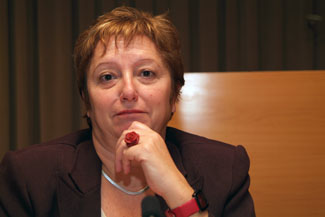Eulália Pérez, head of the Spanish Foundation for Science and Technology (FECYT)

"Hierarchical discrimination is very subtle, it builds up little by little and keeps women at the lower levels of the scientific hierarchy"
A graduate in Philosophy and doctor of Philosophy from the Universitat Autònoma de Madrid, Eulalia Pèrez is professor of Logic and Philosophy of Science at the University of the Basque Country and lecturer in Science, Technology and Gender at the Institute of Philosophy of CSIC. She has also lectured at the Complutense University in Madrid, the University of Barcelona, the University of Cambridge (UK) and the University of Berkeley (USA). Since 2006 she has held the post of director of the Spanish Foundation for Science and Technology (FECYT) part of the Spanish Ministry of Education and Science. Eulàlia Pérez spoke at the First International Congress on “Gender bias and inequalities in the assessment of academic quality”, which was organised by the UAB Observatory for Equality from 12 to 14 November 2007. In this interview, we review with her the basis of gender inequality in the field of science and technology.
Eulàlia Pérez has undertaken research, mainly in the field of the History of Ancient Science and Scientific Institutions, as well as in the Philosophy of Science, Science, Technology and Society, Scientific Perception and Communication, and Science, Technology and Gender.
She has taken part in many projects both national and international and has been in charge of many research projects among which we should mention Science and values: gender in scientific theories and institutions (1996-1999), From scientific theories to scientific-technological culture and practice (1999-2002), GENTEC: Gender, technology and science in IberoAmerica (2002-2004), The situation of women in the Spanish educational system and in the international context (2003), Social perception of science and technology: stereotypes and perspectives in secondary school students (2005), Training programmes and direct flow and inverse mobility of research staff: problems, challenges and solutions (2005), CTS Interactions in the Biosocial Sciences and Medical Technologies (2004-2006) or Body Sciences and technologies from a CTS perspective (2007-2009).
Since 2006 she has been running the Spanish Foundation for Science and Technology (FECYT), an institution which provides a continuous and flexible service to the Spanish scientific-technological-business system.
- Have women not been protagonists in science? Or is it just that their role has been poorly explained?
- The history of science is explained with a bias. There haven’t been as many women as men in science because they didn’t have access to education (they weren’t taught to read and write, etc.). In Spain, unrestricted access to university dates from 1910. There were only a few, but even so, many more than actually appear in histories of science. That has also got something to do with the idea that we have about the history of science. We think of great names and great discoveries, which are usually to do with men, but the history of science is much more than that. For example, in Biology there are many people collecting specimens, taking samples, classifying. This is something women have taken an active part in.
- The gender perspective, then, widens the horizon of the history of science?
- Of course. The gender perspective has changed many disciplines, and it has changed the history of science enormously, for example, by calling attention to the scientific-literary salons, which were very important during the 17th and 18th centuries for the consolidation of certain ideas and theories.
- What is the situation of women in research today in Spain?
- There are very well qualified researchers, but they tend to be at the lower levels of the career ladder and don’t progress well enough. If positive measures are not applied, it is difficult for them to progress because they tend to get left “at the bottom” and are not promoted. Women represent 37% of researchers, but in contrast, only 13% of professors.
- How is hierarchical discrimination caused?
- That’s difficult to answer. It’s a very subtle discrimination, which builds up little by little and keeps women at the lower levels of the scientific hierarchy. For example: to go up the career ladder you have show merits. Women, often have fewer merits because they work a double or triple shift. Others have the same merits, but are assessed by their peers, who are men. These merits are not assessed equally. Christine Wenneras and Agnes Wold’s study (Nature, 1997) showed that with exactly the same merits, women scored 2.6 points below men.
- Why is it so difficult to detect this discrimination?
- Because we have to look at the internal functioning of the commissions and see how male and female candidates are assessed. This is why studies like Wenneras and Wold’s are so good: they were able to see, one by one, the CVs of all the participants and what they had scored in each section. They discovered that an article published by women received fewer points than one published by a man in the same journal.
- What would you correct in the way that science is taught in the preuniversity field?
- On the one hand, we have to think about the syllabus from age 10 to 18. From what I have seen, many scientific disciplines are repetitive. The same things are repeated many times. On the other we have to instigate a fundamental methodological innovation: more laboratories, more experiments and more trips outside the classroom. And for that we need stimulated teachers. At the moment they are an undervalued group socially speaking. Their salaries don’t correspond to the responsibilities they have. We should reduce the teaching load, reduce the number of students in class and stimulate them to engage in continuous training.
Entrevista: Lucas Santos
Foto: Antonio Zamora


